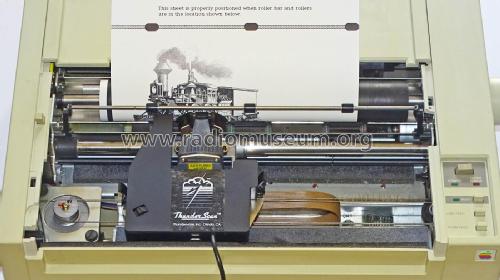Digitizer for Macintosh ThunderScan
Thunderware Inc; Orinda, CA
- Country
- United States of America (USA)
- Manufacturer / Brand
- Thunderware Inc; Orinda, CA
- Year
- 1984
- Category
- Signal Processing and Computing
- Radiomuseum.org ID
- 304702
- Wave bands
- - without
- Power type and voltage
- Other, details in remarks or not known.
- Material
- Plastics (no bakelite or catalin)
- from Radiomuseum.org
- Model: Digitizer for Macintosh ThunderScan - Thunderware Inc; Orinda, CA
- Shape
- Very small Portable or Pocket-Set (Handheld) < 8 inch.
- Dimensions (WHD)
- 110 x 75 x 125 mm / 4.3 x 3 x 4.9 inch
- Notes
-
ThunderScan hardware and software converts the Apple Imagewriter into an inexpensive but low-speed scanner for early Macintosh computers. In use, the ink cartridge of the Imagewriter is replaced by an optical scanner cartridge which is driven by the software to scan a document as it is automatically fed around the platen. An adapter box that is connected in the cable between the Imagewriter and the computer allows switching between printing and scanning without changing the plug connections.
For scanning, the front section of the printer cover is removed and replaced by one that leaves a slot for the passage of the cable from the scanner cartridge. A small velcro pad is provided to keep the cable in place while scanning, and the replacement cover has a magnet to operate the safety switch. For the highest scanning speed, a white adhesive-backed timing tape is installed on the left hand edge of the Imagewriter platen. Four tapes were supplied with the kit. The scanner cartridge has a focusing adjustment.
Unlike the print head, which can deposit 9 rows of dots at a time, ThunderScan can only capture one scan line of data on each pass of the scanner head. Hence it only advances 1/144 inch per pass and is 9 times slower than printing. While optional bidirectional scanning is supported, accurate alignment can be a problem and somewhat higher quality is obtained with unidirectional scanning, which further reduces the speed. The scanner can record 5 bits per pixel (i.e., up to 32 shades of grey), although early Macintoshes couldn't display this except by software rendering. Depending on the magnification selected, resolution varies from 18 to 288 dpi.
Other versions of ThunderScan were produced for Apple II computers, for Imagewriter II, for later Macs with Mini DIN 8 connectors, and for hand scanning. The version for early Macs was powered from the computer's serial port, while some later versions required an external power source. ThunderScan sales peaked in 1987, and around 100,000 units were sold before the improving price/performance ratio of faster and quieter flatbed scanners rendered it obsolete.
- Net weight (2.2 lb = 1 kg)
- 0.930 kg / 2 lb 0.8 oz (2.048 lb)
- Price in first year of sale
- 249.00 USD
- Author
- Model page created by Bruce Taylor. See "Data change" for further contributors.
- Other Models
-
Here you find 1 models, 1 with images and 0 with schematics for wireless sets etc. In French: TSF for Télégraphie sans fil.
All listed radios etc. from Thunderware Inc; Orinda, CA
Collections
The model Digitizer for Macintosh is part of the collections of the following members.





